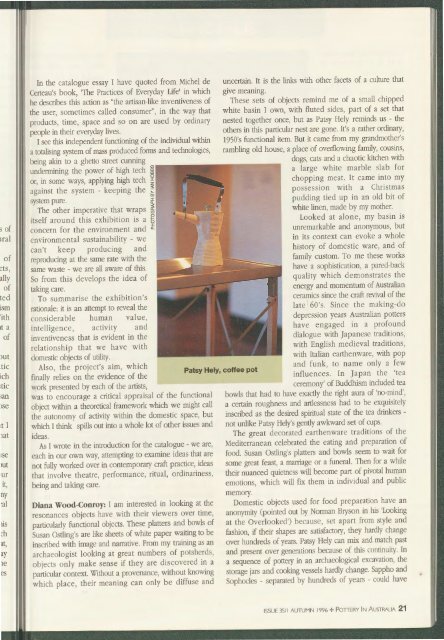Pottery In Australia Vol 35 No 1 Autumn 1996
You also want an ePaper? Increase the reach of your titles
YUMPU automatically turns print PDFs into web optimized ePapers that Google loves.
of<br />
fal<br />
of<br />
ts,<br />
lly<br />
of<br />
ed<br />
sm<br />
ith<br />
t a<br />
of<br />
Ut<br />
tic<br />
ch<br />
;tic<br />
,an<br />
)Se<br />
Lt I<br />
1at<br />
1se<br />
mt<br />
,ur<br />
it,<br />
ny<br />
ral<br />
1is<br />
ch<br />
at,<br />
ay<br />
1e<br />
es<br />
<strong>In</strong> the catalogue essay I have quoted from Michel de<br />
Certeau's book, 'The Practices of Everyday Life' in which<br />
he describes this action as "the artisan-like inventiveness of<br />
the user, sometimes called consumer", in the way that<br />
products, time, space and so on are used by ordinary<br />
people in their everyday lives.<br />
I see this independent functioning of the individual within<br />
a totalising system of mass produced forms and technologies,<br />
being akin to a ghetto street cunning<br />
undermining the power of high tech<br />
or, in some ways, applying high tech<br />
against the system - keeping the<br />
system pure.<br />
The other imperative that wraps<br />
itself around this exhibition is a<br />
concern for the environment and<br />
environmental sustainability - we<br />
can't keep producing and<br />
reproducing at the same rate with the<br />
same waste - we are all aware of this.<br />
So from this develops the idea of<br />
taking care.<br />
To summarise the exhibition's<br />
rationale: it is an attempt to reveal the<br />
considerable human value,<br />
intelligence, activity and<br />
inventiveness that is evident in the<br />
relationship that we have with<br />
domestic objects of utility.<br />
Also , the project's aim, which<br />
finally relies on the evidence of the<br />
work presented by each of the artists,<br />
was to encourage a critical appraisal of the functional<br />
object within a theoretical framework which we might call<br />
the autonomy of activity within the domestic space, but<br />
which I think spills out into a whole lot of other issues and<br />
ideas.<br />
As I wrote in the introduction for the catalogue - we are,<br />
each in our own way, attempting to examine ideas that are<br />
not fully worked over in contemporary craft practice, ideas<br />
that involve theatre, performance, ritual, ordinariness,<br />
being and taking care.<br />
Diana Wood-Conroy: I am interested in looking at the<br />
resonances objects have with their viewers over time,<br />
particularly functional objects. These platters and bowls of<br />
Susan Ostling's are like sheets of white paper waiting to be<br />
inscribed with image and narrative. From my training as an<br />
archaeologist looking at great numbers of potsherds,<br />
objects only make sense if they are discovered in a<br />
particular context. Without a provenance, without knowing<br />
which place, their meaning can only be diffuse and<br />
uncertain. It is the links with other facets of a culture that<br />
give meaning.<br />
These sets of objects remind me of a small chipped<br />
white basin I own, with fluted sides, part of a set that<br />
nested together once, but as Patsy Hely reminds us - the<br />
others in this particular nest are gone. It's a rather ordinary,<br />
1950's functional item. But it came from my grandmother's<br />
rambling old house, a place of overflowing family, cousins,<br />
dogs, cats and a chaotic kitchen with<br />
a large white marble slab for<br />
chopping meat. It came into my<br />
possession with a Christmas<br />
pudding tied up in an old bit of<br />
white linen, made by my mother.<br />
Looked at alone, my basin is<br />
unremarkable and anonymous, but<br />
in its context can evoke a whole<br />
history of domestic ware, and of<br />
family custom. To me these works<br />
have a sophistication, a pared-back<br />
quality which demonstrates the<br />
energy and momentum of <strong>Australia</strong>n<br />
ceramics since the craft revival of the<br />
late 60's. Since the making-do<br />
depression years <strong>Australia</strong>n potters<br />
have engaged in a profound<br />
dialogue with Japanese traditions,<br />
with English medieval traditions,<br />
with Italian earthenware, with pop<br />
and funk, to name only a few<br />
influences. <strong>In</strong> Japan the 'tea<br />
Patsy Hely, coffee pot<br />
ceremony' of Buddhism included tea<br />
bowls that had to have exactly the right aura of 'no-mind',<br />
a certain roughness and artlessness had to be exquisitely<br />
inscribed as the desired spiritual state of the tea drinkers -<br />
not unlike Patsy Hely's gently awkward set of cups.<br />
The great decorated earthenware traditions of the<br />
Mediterranean celebrated the eating and preparation of<br />
food. Susan Ostling's platters and bowls seem to wait for<br />
some great feast, a marriage or a funeral. Then for a while<br />
their nuanced quietness will become part of pivotal human<br />
emotions, which will fix them in individual and public<br />
memory.<br />
Domestic objects used for food preparation have an<br />
anonymity (pointed out by <strong>No</strong>rman Bryson in his 'Looking<br />
at the Overlooked') because, set apart from style and<br />
fashion, if their shapes are satisfactory, they hardly change<br />
over hundreds of years. Patsy Hely can mix and match past<br />
and present over generations because of this continuity. <strong>In</strong><br />
a sequence of pottery in an archaeological excavation, the<br />
storage jars and cooking vessels hardly change. Sappho and<br />
Sophocles - separated by hundreds of years - could have<br />
ISSUE <strong>35</strong>/1 AUTUMN <strong>1996</strong> + POTTERY IN A USTRALIA 21

















